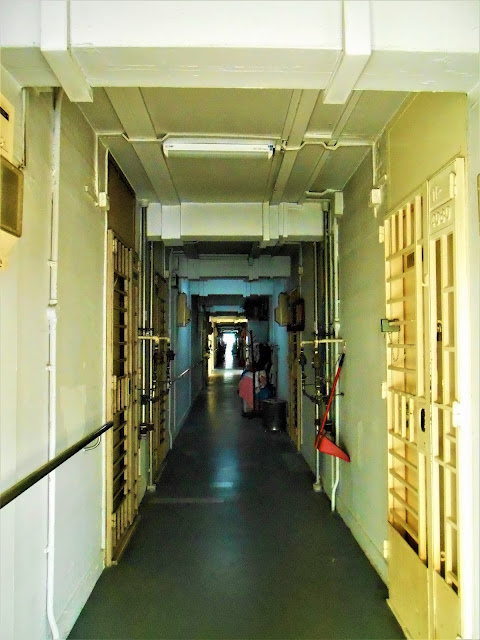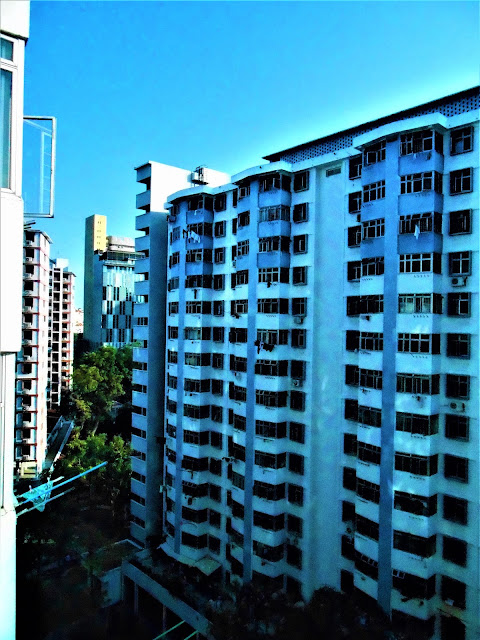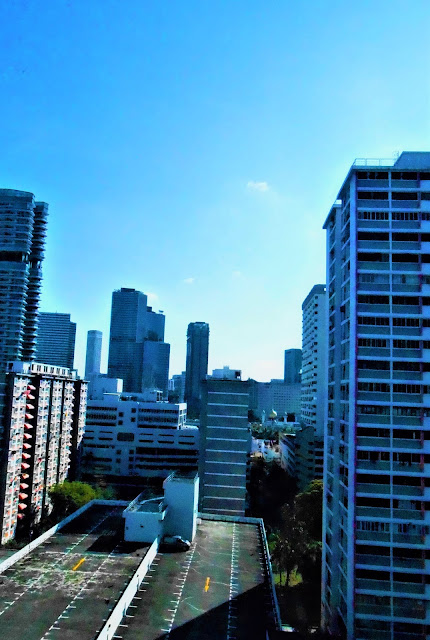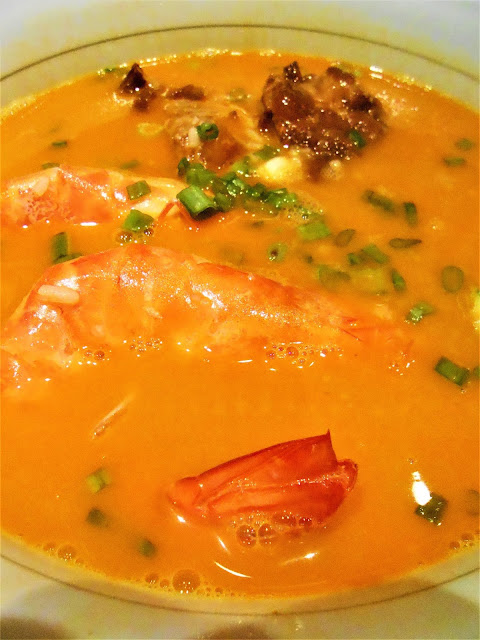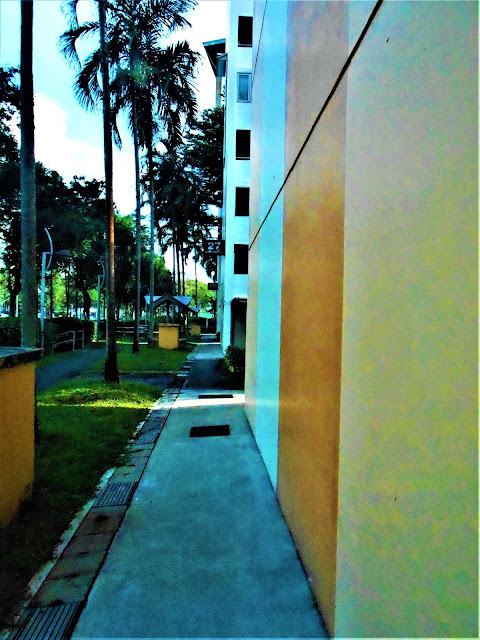A friend of mine used to live around here.
We haven't seen each other for a while.
Not because we had a fight or anything like that.
Just that we move in different circles and have different lifestyles and so don't get to hang out together as much as we used to do.
There'll come a day where we'll meet for a coffee once again.
And maybe I'll ask her to meet at this 'hood which she knows so well.
There might be neighbors she wants to see.
There might be neighbors she doesn't want to see.
I don't know.
She told me one time that there were many elderly living in her 'hood.
She wasn't wrong.
When I went there on this particular afternoon there were indeed a good number of senior citizens hanging about.
Some of them looked like they had come downstairs for a short walk around the basketball court.
Others looked like they were going to the shops or to the coffee shop for an early evening meal.
There were those who sat on the seats under the trees.
And there were those who wheeled themselves down to a corner of the void deck to read the newspaper and bask in the late afternoon breeze.
It isn't a neighborhood like some of the other housing estates are.
There isn't a dedicated bus interchange like what Bukit Merah, Tampines and Woodlands have.
There isn't a dedicated MRT station like what Jurong East, Ang Mo Kio, Redhill and Choa Chu Kang have.
They don't even have a town center nor a supermarket nor a library or even a swimming pool that they can call their own.
To look at it strictly, it really is just a couple of blocks rising up from the banks of the Rochor River, starting from one end of North Bridge Road towards Jalan Sultan, stretching southwards towards present day Beach Road.
It's strange how I've always walked through this estate to get to Golden Mile Complex on Beach Road or to Jalan Sultan on the other side, but I've never really gone into this estate nor have I ever gone up to take a look at the views.
They're a compact set of blocks- built fairly close together to each other so much so that you can literally look out your window into the home of your neighbor in the block opposite- and their corridors are a single long enclosed stretch with one lift landing in the middle, one lift landing at the end, and doors on either side.
To walk through their corridors from one end to the other is to walk from bright light to cool dim light to very dim light to cool dim light to bright light again. You get one day's worth of light just by walking up and down the corridors.
To some, dwelling in spaces like this might seem like a severe, even uncomfortable, lack of privacy.
But we are a small country- and prior to these high rise flats- we were already living in close knit communities in houses side by side.
It is possible that close-quarter living can breed a sense of unity, togetherness and neighborliness.
It is also possible that one can easily enter the realm of dispute, disagreement, conflict and busy-bodies.
But in the cocoon of the single door and the neat little windows, in the appearance of uniformity, there is the presence of privacy and the expression of individualism.
There might have been similarities- many flats were bathed in similar hues of golden afternoon light- but no two homes were exactly the same.
One thing I've noticed about blocks with smaller units is how the corridors become a part of their own living patterns, and their own choice of lifestyle.
At some staircase landings one might find tables and chairs arranged nicely and neatly for family or neighborly gatherings.
At other staircase landings there might be a bicycle, a market trolley or even a well-watered plant or two.
Some residents placed their televisions right next to the door.
Others placed theirs against the wall close to the window.
There were residents who had their beds right next to the main door.
But there were those who placed them right under the window.
Everyone arranged their furniture differently.
At one house the (foldable) dining table might be right outside the low wall of the kitchen right in front of the main door.
At another, in the same spot there might be a comfortable chair.
There were residents whose homes had the basics of furniture to make room for their wheelchairs.
But there were residents whose furniture included cushions and towels and fabrics of colorful kinds.
At one home the walls were painted a bright green.
At another a karaoke set filled the space next to the front door.
Here and there were the sounds of living.
Here and there were the sights of life and living as persons moved around.
There were residents who had their doors wide open.
There were residents who had their doors slightly ajar.
And there were residents who had their doors closed entire.
In a space like this, everyone has their own perspective of noise, of quiet and of privacy.
It is one you learn to respect.
It is one you learn to accept, and understand.
One thing that fascinated me about this place were the views.
Three blocks I visited, three different views I got.
One block gave me the close up view of her neighboring blocks just opposite, together with the sight of Kallang River peeking through the blocks situated across from her.
On the other end of the same side, she gave me more close ups of the blocks in front, as well as the view of Beach Road and Millennia Walk in the horizon.
It's controversial perhaps (it might be the view of a visitor) but I found the geometry of the housing blocks- their structure, their nearness to where I was- strangely unique and beautiful.
From the other block- the one facing Jalan Sultan and the entire length of North Bridge Road- I got a very clear view of Beach Road, where between the high-rises I could see the tip of Marina Bay Sands, and the hotel tower of Swissotel somewhere in the middle.
The view here was decidedly urban.
To my left was the Golden Mile Complex and Golden Mile Tower. In front of me were the point blocks from the neighboring 'hood (actually the same 'hood but on different streets) and right below, between the trees of the car park- the Golden Mile Food Center- with her Army Market, and her interesting foods.
I'd been impressed by the views from the high-rise corridors of these two.
But nothing- NOTHING- prepared me for what I saw when I got to the top floor of the third block I visited on this particular afternoon.
To my left and right on either side were corridors dim, dark and cool.
Yet, stretched out in front of me, beyond the safety of concrete landing and metal railing, was this wide expanse of light, space, and scenery.
It stunned me.
I had not known that from this block you could see all the way past the Kallang River to the National Stadium to the blocks of Geylang Bahru, Old Airport Road, Aljunied and the east coast.
Neither had I known that the view stretched all the way northwards past the industrial areas of Kallang towards Bendemeer, Towner, the opposite banks of the Kallang River, and perhaps parts of Macpherson and Potong Pasir.
I'd gasped.
There was all this light!
There was all this space!
Where everything was laid out so beautifully like a carpet, in a surprising juxtaposition of modernity and development and heritage, reflecting the shifts of space and time.
It was a hopeful view.
But also, a contemplative one.
I've always been of the thought that our surroundings influence who we are, what we are, and how we see ourselves. It doesn't matter how exclusive or inclusive our neighborhoods are. It doesn't matter even how we live. But the place we come back to, the view we come back to (if we have a view at all)- they influence us, and eventually, whether we stay there long or short or not at all, they define us.
Maybe some decide that they shall be content to watch the world in front of their windows change whilst they remain put.
Maybe some decide that they have a rightful place to belong in this world beyond their walls and work hard to be a significant part of it.
And maybe some decide that there's no use heading out to the world beyond but safer to remain where they are and hopefully become a place where those out there can return.
We won't know.
We won't know how us who live amongst these walls see ourselves.
We have come to a stage where many of us can actually express to society who, and what we really are.
But it is a growth journey and before that we have to first reach a decision that it is us who is responsible for the life that we possess; that it is us to love and define for ourselves who we can be, and who we genuinely see ourselves to be.
I will not be wandering about this estate for a while.
There's nothing more- for the time being- that I think I ought to see.
But one day I hope to come back here with my friend again.
I'd like to ask her to bring me around.
I'd like to ask her to tell me stories of the neighbors she once knew.
And I'd like to ask if she often went upstairs to look at the view that I (somehow) on this one afternoon managed to see.





